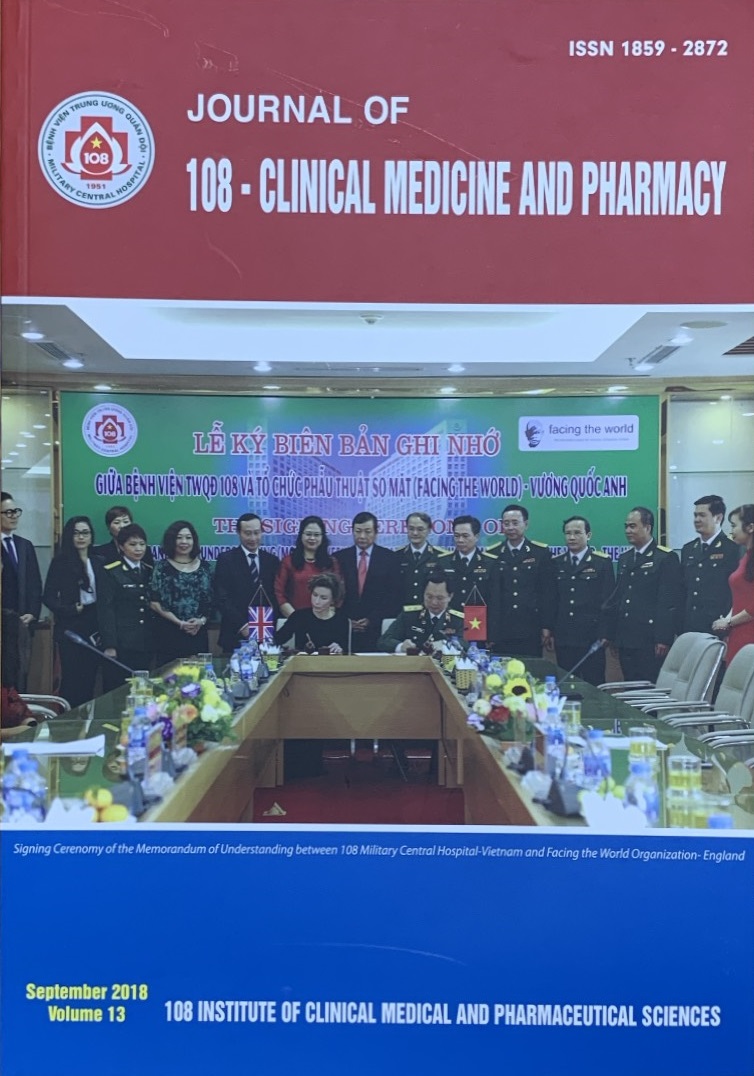Results of percutaneous nephrolithotomy for the treatment of renal stones larger than 2cm
Main Article Content
Keywords
Tóm tắt
Objective: This study aims to evaluate the results of percutaneous nephrolithotomy (PCNL) for the treatment of renal stones larger than 2cm. Subject and method: A prospective study carried out on 139 patients with renal stones larger than 2cm treated by percutaneous nephrolithotomy (PCNL) from December 2009 to December 2016 at 108 Military Central Hospital. Result: Among 139 patients studied, the mean age of patients was: 50.6 ± 10.7 years. The mean stone size was 3.97 ± 1.46cm. The mean operative time was 107.8 ± 31.1 minutes. The PCNL procedure was successfully completed in all patients. The success rate (stone-free status) was 77% (107/139). The mean post-operative hospital stay was 6.2 ± 2.7 days. The overall complications were observed in 22.3% of cases (31/139). According to the Clavien-Dindo classification: Grade 1 (12.9%), grade 2 (7.2%), grade 3 (2.8%), grade 4 (0.7%), grade 5 (0%). Conclusion: PCNL is a minimally invasive, safe and effective choice of treatment for renal stone larger than 2cm with high success rate.
Keywords: Renal stones, percutaneous nephrolithotomy.
Article Details
Các tài liệu tham khảo
2. Trương Văn Cẩn (2014) Phẫu thuật lấy sỏi thận qua da tại Bệnh viện Trung ương Huế. Tạp chí Y Dược học, Đặc san Hội nghị Khoa học thường niên lần thứ VIII - Hội Tiết niệu Thận học Việt Nam, tr. 40-46.
3. Võ Phước Khương, Vũ Lê Chuyên (2012) Lấy sỏi qua da với đường vào thận từ đài dưới trong điều trị sỏi thận phức tạp. Y học Thành phố Hồ Chí Minh, Chuyên đề Thận niệu, Phụ bản của tạp chí 16(3), tr. 204-211.
4. Rosette JJ, Opondo D et al (2012) Categorisation of complications and validation of the Clavien score for percutaneous nephrolithotomy. Eur Urol 62(2): 246-255.
5. C Türk TK, Petrik A, Sarica K, Seitz C, Straub M, Traxer O (2010) Guidelines on urolithiasis, European Association of Urology 20.
6. David A, Leavitt M et al (2016) Strategies for nonmedical management of upper urinary tract calculi campbell-wash urology. Vol. 2, 11th, Elsevier, Philadenphia: 1235-1259.
7. Raman JD, Bagrodia A et al (2010) Residual fragments after percutaneous nephrolithotomy: Cost comparison of immediate second look flexible nephroscopy versus expectant management. J Urol 183(1): 188-193.
8. Rizvi SAH, Hussain M et al (2017) Surgical outcomes of percutaneous nephrolithotomy in 3402 patients and results of stone analysis in 1559 patients. BJU Int 120(5): 702-709.
9. Rosette J, Assimos D et al (2011) The clinical research office of the endourological society percutaneous nephrolithotomy global study: Indications, complications, and outcomes in 5803 patients. J Endourol 25(1): 11-17.
10. de Souza Melo PA, Vicentini FC et al (2018) Outcomes of more than 1,000 percutaneous nephrolithotomies and validation of Guy's stone score. BJU Int 121(4): 640-646.
 ISSN: 1859 - 2872
ISSN: 1859 - 2872
